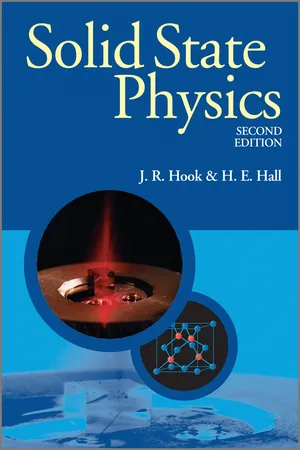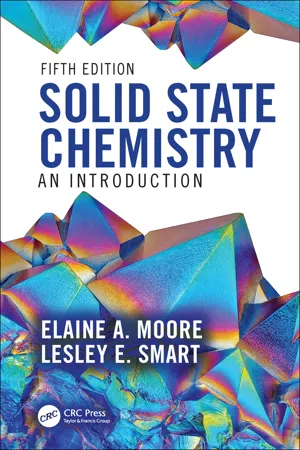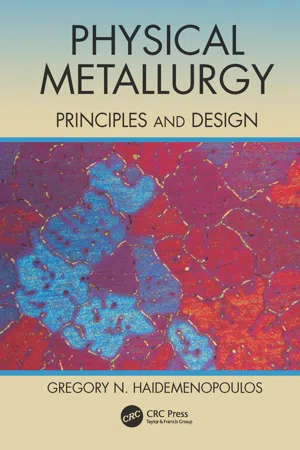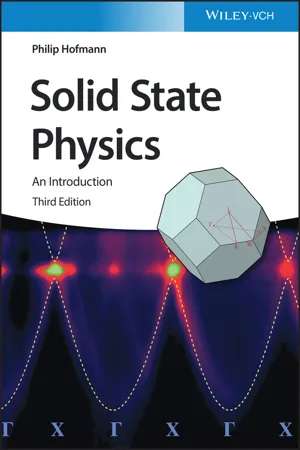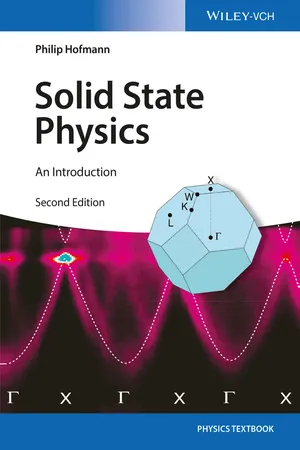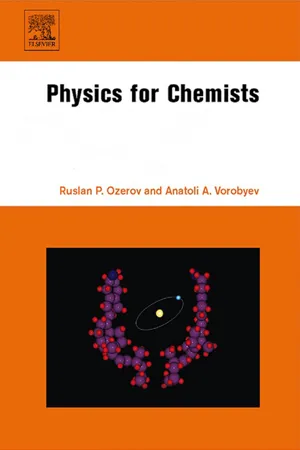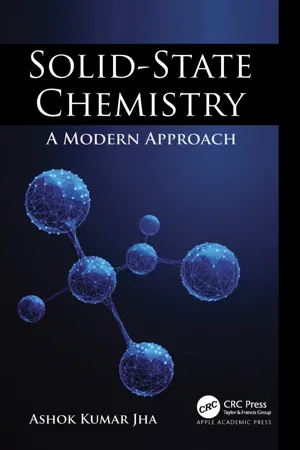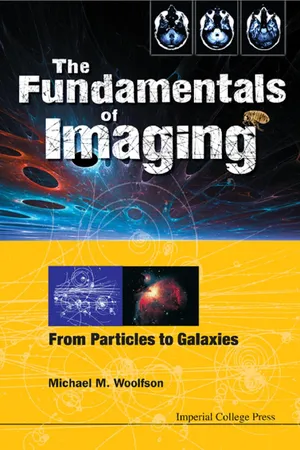Physics
Crystal Structure
Crystal structure refers to the arrangement of atoms or molecules in a crystalline material. It is characterized by a repeating, three-dimensional pattern that gives crystals their unique shape and properties. The arrangement of these building blocks determines the crystal's symmetry, density, and other physical properties.
Written by Perlego with AI-assistance
Related key terms
Related key terms
1 of 4
Related key terms
1 of 3
11 Key excerpts on "Crystal Structure"
- eBook - ePub
- J. R. Hook, H. E. Hall(Authors)
- 2013(Publication Date)
- Wiley(Publisher)
CHAPTER 1
Crystal Structure
Beauty when uncloth’d is clothè d best.—Phineas Fletcher (1582–1650)1.1 INTRODUCTION
The aim of solid state physics is to explain the properties of solid materials as found on Earth. For almost all purposes the properties are expected to follow from Schrödinger’s equation for a collection of atomic nuclei and electrons interacting with electrostatic forces. The fundamental laws governing the behaviour of solids are therefore known and well tested. It is nowadays only in cosmology, astrophysics and high-energy physics that the fundamental laws are still in doubt.In this book we shall be concerned almost entirely with crystalline solids, that is solids with an atomic structure based on a regular repeated pattern, a sort of three-dimensional wallpaper. Many important solids are crystalline in this sense, although this is not always manifest in the external form of the material. Because calculations are easier, more progress has been made in understanding the behaviour of crystalline than of non-crystalline materials. Many common solids—for example, glass, plastics, wood, bone—are not so highly ordered on an atomic scale and are therefore non-crystalline. Only recently has progress been made in understanding the behaviour of non-crystalline solids at a fundamental level.†Even in the restricted field of crystalline solids the most remarkable thing is the great variety of qualitatively different behaviour that occurs. We have insulators, semiconductors, metals and superconductors—all obeying different macroscopic laws: an electric field causes an electric dipole moment in an insulator (Chapter 9), a steady current in a metal or semiconductor (Chapters 3 to 6) and a steadily accelerated current in a superconductor (Chapter 10). Solids may be transparent or opaque, hard or soft, brittle or ductile, magnetic or nonmagnetic.In this chapter we first introduce in Section 1.2 the basic ideas of crystallography. In Section 1.3 we describe some important Crystal Structures and in Section 1.4 we explain how x-ray diffraction is used to determine Crystal Structure. In Section 1.5 we discuss quasi-crystals, ordered solids that challenge much of the conventional wisdom concerning crystalline materials. Section 1.6 contains a qualitative description of the interatomic forces responsible for binding atoms into solids. - eBook - ePub
Solid State Chemistry
An Introduction
- Elaine A. Moore, Lesley E. Smart(Authors)
- 2020(Publication Date)
- CRC Press(Publisher)
Crystal Structures are usually determined by the technique of X-ray crystallography. This technique relies on the fact that the distances between the atoms in the crystals are of the same order of magnitude as the wavelength of X-rays (of the order of 1 Å or 100 pm): a crystal thus acts as a three-dimensional diffraction grating to a beam of X-rays. The resulting diffraction pattern can be interpreted to give the internal positions of the atoms in the crystal very precisely, thus defining interatomic distances and angles. (Some of the principles underlying this technique are discussed in Chapter 2, where we review the physical methods available for characterising solids.) Most of the structures discussed in this book would have been determined in this way. 1.2 Lattices and Unit Cells Crystals are regular-shaped solid particles with flat shiny faces. In 1664, Robert Hooke first noted that the regularity of their external appearance is a reflection of a high degree of internal order. Crystals of the same substance, however, vary in shape considerably. In 1671, Nicolas Steno observed that this is not because their internal structure varies, but because some faces develop more than others. The angles between similar faces on different crystals of the same substance are always identical. The constancy of the interfacial angles reflects the internal order within the crystals. Each crystal is derived from a basic ‘building block’ that repeats over and over again, in all directions, in a perfectly regular way. This building block is known as the unit cell. In order to talk about and compare the many thousands of Crystal Structures that are known, there has to be a way of defining and categorising the structures. This is achieved by defining the shape, symmetry, and also the size of each unit cell and the positions of the atoms within it. 1.2.1 Lattices The simplest regular array is a line of evenly spaced objects such as that depicted by the commas in Figure 1.1a - eBook - ePub
- Anthony R. West(Author)
- 2014(Publication Date)
- Wiley(Publisher)
1 Crystal Structures and Crystal ChemistrySolid state chemistry is concerned mainly with crystalline inorganic materials, their synthesis, structures, properties and applications. A good place to begin is with Crystal Structures and crystal chemistry . All necessary Crystal Structure information is contained in data on unit cells, their dimensions and the positions or atomic coordinates of atoms inside the unit cell. Crystal chemistry combines this basic structural information with information about the elements, their principal oxidation states, ionic radii, coordination requirements and preferences for ionic/covalent/metallic bonding. A working knowledge of the Periodic Table and the properties of elements is, of course, invaluable to be able appreciate crystal chemistry, but conversely, knowledge of Crystal Structures and especially crystal chemistry provides a very useful way to gain increased understanding of the elements and their compounds.Many of the properties and applications of crystalline inorganic materials revolve around a surprisingly small number of structure types. In this chapter, the main families of inorganic structures are reviewed, especially those which have interesting properties; more details of the vast array of structures may be found in the encyclopaedic text by Wells and also in the Wyckoff Crystal Structures book series. First, however, we must consider some basic concepts of crystallography.1.1 Unit Cells and Crystal SystemsCrystals are built up of regular arrangements of atoms in three dimensions; these arrangements can be represented by a repeat unit or motif called the unit cell . The unit cell is defined as the smallest repeating unit which shows the full symmetry of the Crystal Structure . Let us see exactly what this means, first in two dimensions. A section through the NaCl structure is shown in Fig. 1.1(a) ; possible repeat units are given in (b) to (e). In each, the repeat unit is a square and adjacent squares share edges and corners. Adjacent squares are identical, as they must be by definition; thus, all the squares in (b) have Cl− - eBook - ePub
Physical Metallurgy
Principles and Design
- Gregory N. Haidemenopoulos(Author)
- 2018(Publication Date)
- CRC Press(Publisher)
2Structure of metals
2.1 Introduction
The study of structure of metals is the first essential step towards the understanding of their behavior in service and during processing. Metals are crystalline solids, i.e., they exhibit a Crystal Structure . Atoms in a Crystal Structure occupy positions in an arrangement, which is characterized by periodicity . The atomic arrangement is systematically repeated in three-dimensional space. Despite the qualitative descriptions of the Crystal Structure of metals in the past centuries, it was not until 1912, when X-rays were first used for the study of structure, that a proof of the Crystal Structure of metals was obtained. The discovery of X-ray diffraction by Laue and the observation, by Bragg, of X-ray scattering from evenly spaced planes within the crystal, set the foundations for the development of Physical Metallurgy. The scientific field concerned with the study of Crystal Structure is termed Crystallography . For the first time scientists had a way to determine the shape and size of the building block of the crystal, the unit cell , as well as the arrangement of atoms within the unit cell. The way towards creating links between structure and properties of metals was established. A complete coverage of the science of crystallography is out of the scope of this chapter. Only fundamental elements, especially those which highlight the correlation between structure and properties of metals, will be discussed here. For a more complete treatment, the reader is advised to study the bibliography at the end of this chapter.2.2 Crystalline vs. Amorphous Materials
As discussed above the Crystal Structure is an orderly and periodic array of atoms. Not all materials exhibit a Crystal Structure. In crystals, when the liquid is cooled below the freezing point, it transforms into a crystalline solid. Some liquids, however, due to either a complex atomic configuration or limited atomic mobility, do not organize into a crystalline arrangement, but instead they form a disordered array of atoms. Actually this disordered state resembles the atomic arrangement in the liquid state and is called a glass . Glasses lack long range order and are therefore amorphous materials . The transition from the liquid to the glassy or amorphous state is gradual and takes place at theglass transition temperature Tg. On the other hand the transition from the liquid to the crystalline state for crystalline materials is abrupt, and takes place at themelting point Tm. Although metals are generally crystalline, it is possible, under certain conditions, to produce amorphous metals, called metallic glasses - eBook - ePub
Solid State Physics
An Introduction
- Philip Hofmann(Author)
- 2022(Publication Date)
- Wiley-VCH(Publisher)
amorphous. The amorphous state is characterized by the absence of any long‐range order. There may exist, however, a degree of short‐range order between the atoms.This chapter is divided into three parts. In the first part, we define some basic mathematical concepts needed to describe crystals. We keep things simple and mostly use two‐dimensional examples to illustrate the ideas. In the second part, we discuss common Crystal Structures. For the moment, we will not ask why the atoms bind together in the way they do – this topic will be discussed in Chapter 2 . Finally, we delve into a more detailed discussion of X‐ray diffraction, the experimental technique that can be used to determine the microscopic structure of crystals. X‐ray diffraction is used not only in solid state physics but also for a wide range of problems in nanotechnology and structural biology.1.1 General Description of Crystal Structures
Our description of crystals starts with the mathematical definition of the lattice. A lattice is a set of regularly spaced points with positions defined as multiples of generating vectors. In two dimensions, a lattice can be defined as all the points that can be reached by the vectors , created from two non‐collinear vectors and as(1.1)where and are integers. In three dimensions, the corresponding definition is(1.2)Such a lattice of points is also called a Bravais lattice. The number of possible Bravais lattices with different symmetries is limited to 5 in two dimensions and to 14 in three dimensions. An example of a two‐dimensional Bravais lattice is given in Figure 1.1 . The lengths of the vectors and are often called the lattice constants.Having defined the Bravais lattice, we move on to the definition of the primitive unit cell. By this we denote any volume of space that, when translated through all the vectors of the Bravais lattice, will fill space without overlap and without leaving any voids. The primitive unit cell of a lattice contains only one lattice point. It is also possible to define nonprimitive unit cells containing several lattice points. These fill space without leaving voids when translated through a subset of the Bravais lattice vectors. Possible choices of a unit cell for a two‐dimensional rectangular Bravais lattice are illustrated in Figure 1.2 . It is evident from the figure that a nonprimitive unit cell has to be translated by a multiple of one (or two) lattice vectors to fill space without voids and overlap. A special choice of the primitive unit cell is the Wigner–Seitz cell, which is also shown in Figure 1.2 - eBook - ePub
Solid State Physics
An Introduction
- Philip Hofmann(Author)
- 2015(Publication Date)
- Wiley-VCH(Publisher)
This chapter is divided into three parts. In the first part, we define some basic mathematical concepts needed to describe crystals. We keep things simple and mostly use two-dimensional examples to illustrate the ideas. In the second part, we discuss common Crystal Structures. At this point, we do not ask why the atoms bind together in the way that they do, as this is treated in the next chapter. Finally, we go into a somewhat more detailed discussion of X-ray diffraction, the experimental technique that can be used to determine the microscopic structure of crystals. X-ray diffraction is used not only in solid state physics but also for a wide range of problems in nanotechnology and structural biology.1.1 General Description of Crystal Structures
Our description of crystals starts with the mathematical definition of the lattice. A lattice is a set of regularly spaced points with positions defined as multiples of generating vectors. In two dimensions, a lattice can be defined as all the points that can be reached by the vectors , created from two vectors and as1.1where n and m are integers. In three dimensions, the definition is1.2Such a lattice of points is also called a Bravais lattice. The number of possible Bravais lattices that differ by symmetry is limited to 5 in two dimensions and to 14 in three dimensions. An example of a two-dimensional Bravais lattice is given in Figure 1.1 . The lengths of the vectors and are often called the lattice constants.Example for a two-dimensional Bravais lattice.Figure 1.1Having defined the Bravais lattice, we move on to the definition of the primitive unit cell. This is any volume of space that, when translated through all the vectors of the Bravais lattice, fills space without overlap and without leaving voids. The primitive unit cell of a lattice contains only one lattice point. It is also possible to define nonprimitive unit cells that contain several lattice points. These fill space without leaving voids when translated through a subset of the Bravais lattice vectors. Possible choices of a unit cell for a two-dimensional rectangular Bravais lattice are given in Figure 1.2 . From the figure, it is evident that a nonprimitive unit cell has to be translated by a multiple of one (or two) lattice vectors to fill space without voids and overlap. A special choice of the primitive unit cell is the Wigner–Seitz cell that is also shown in Figure 1.2 - eBook - ePub
- Ruslan P. Ozerov, Anatoli A. Vorobyev(Authors)
- 2007(Publication Date)
- Elsevier Science(Publisher)
9Solid State Physics
Publisher Summary
This chapter outlines the crystalline state of a solid. A crystal can be characterized both by the unit cell (the carrier of the chemical composition and atomic structure) and by three translation vectors a , b, and c. The three translation vectors can be used to build the whole crystal from original cells. Each of these three vectors corresponds to a symmetry operation because these operations superpose a crystal with themselves. Each atom (supposed to be a point) moves over to a similar atom in the nearby unit cell. Any point can be transferred to another crystal point, identical to the first, by operation of a translation. Translation is an attribute of the crystalline state because it translates a given atom to a similar one in the neighboring unit cell but does not combine an atom with itself. It is important to note that the crystal is considered to be of infinite size; this is a good approximation because crystal size is usually many orders of larger value than the unit cell.Solids are mostly subdivided into crystal and amorphous substances. In this chapter the crystalline state is predominantly considered although some features of the amorphous and liquid states will also be briefly touched on.9.1 Crystal Structure, CRYSTAL LATTICE
A crystal is characterized by a three-dimensional, regular, periodic array of particles—atoms and/or molecules. Modern experimental techniques allow us to see the structure of large molecules in crystals using an electron microscope. Figure 9.1 is an electron photograph of a crystal of tobacco mosaic virus, showing the regular packing of the molecules in a crystal.Figure 9.1 Image of the tobacco mosaic crystal as seen in the electron microscope (size of molecules is approximately 25 nm).Remember that by “molecule” we usually mean the smallest part of a substance that can exist alone and retain the characteristics of that substance. Imagine that we can divide a crystal until it becomes the “brick,” which retains the main (but, certainly, not all) characteristics of the whole crystal. The contents and form of this “brick” defines the Crystal Structure: the relative amount and mutual disposition of atoms (molecules), the chemical composition of crystalline material, the interatomic distances and valence angles (i.e., chemical bonding), etc. The smallest part of the crystal that retains the specified characteristics (the “brick”) is referred to as a unit cell. Using the property of periodicity one can build the whole crystal by regular repetition of unit cells along coordinate axes, as shown in Figure 9.2 - eBook - ePub
Solid-State Chemistry
A Modern Approach
- Ashok Kumar Jha(Author)
- 2023(Publication Date)
- Apple Academic Press(Publisher)
Chapter 3 Crystal StructureAbstract
Crystals are the three-dimensional arrangement of atoms. The unit cell or primitive cell is the smallest building unit of a three-dimensional lattice. The number of atoms per unit cell in a simple cubic, body centered cubic and face centered cubic are 1, 2, and 4 respectively. A lattice plane is defined with miller indices and a particular lattice plane is denoted by hkl. Powder diffractometer is used to know diffraction pattern. The structures similar to cubic ZnS are CuF, SiC, CuCl, and AgI. The mineral fluorite CaF2 possess the structure in which eight tetrahedral interstitial sites are occupied by F- ions and regular sites are occupied by Ca2+ . In the rutile structure of TiO2 , Ti is fixed at the corner and body center. MgAl2 O4 is an example of spinel. The type of silicate glass possesses regular network of SiO4 tetrahedron in a random arrangement. The most commonly used glasses are inorganic silicates,and borates. All glasses are amorphous solids or non-crystalline solids. Structure, property and application has also been dealt with.3.1 Introduction
Three-dimensional periodic arrangement of atoms gives rise to a crystal. When crystallization occurs, identical building blocks add continuously to form a three-dimensional network. It has been discovered by mineralogist that the index numbers of orientations of the crystal faces are integers. The periodic array of similar particle gives rise to the law of integral indices.________________ Solid-State Chemistry: A Modern Approach. Ashok Kumar Jha, PhD (Auth.) © 2023 Apple Academic Press, Inc. Co-published with CRC Press (Taylor & Francis)The lattice describes the structure of crystals in which atoms are attached to every lattice point. The basis is formed from the group of atoms. The repetition in space gives rise to the Crystal Structure. - R. E. Smallman, R J Bishop(Authors)
- 1999(Publication Date)
- Butterworth-Heinemann(Publisher)
2.1b , one can appreciate why the structures of comparatively highly-ordered crystalline substances, such as chemical compounds, minerals and metals, have tended to be more amenable to scientific investigation than glasses.2.2 Crystal lattices and structures
We can rationalize the geometry of the simple representation of a Crystal Structure shown in Figure 2.1a by adding a two-dimensional frame of reference, or space lattice, with line intersections at atom centres. Extending this process to three dimensions, we can construct a similar imaginary space lattice in which triple intersections of three families of parallel equidistant lines mark the positions of atoms (Figure 2.2a ). In this simple case, three reference axes (x, y, z ) are oriented at 90° to each other and atoms are ‘shrunk’, for convenience. The orthogonal lattice of Figure 2.2a defines eight unit cells, each having a shared atom at every corner. It follows from our recognition of the inherent order of the lattice that we can express the geometrical characteristics of the whole crystal, containing millions of atoms, in terms of the size, shape and atomic arrangement of the unit cell, the ultimate repeat unit of structure.2Figure 2.2 Principles of lattice construction.We can assign the lengths of the three cell parameters (a, b, c ) to the reference axes, using an internationally-accepted notation (Figure 2.2b ). Thus, for the simple cubic case portrayed in Figure 2.2a , x = y = z = 90°; a = b = c . Economizing in symbols, we only need to quote a single cell parameter (a ) for the cubic unit cell. By systematically changing the angles (α , β , γ ) between the reference axes, and the cell parameters (a, b, c ), and by four skewing operations, we derive the seven crystal systems (Figure 2.3 ). Any crystal, whether natural or synthetic, belongs to one or other of these systems. From the premise that each point of a space lattice should have identical surroundings, Bravais demonstrated that the maximum possible number of space lattices (and therefore unit cells) is 14. It is accordingly necessary to augment the seven primitive (P) cells shown in Figure 2.3 with seven more non-primitive cells which have additional face-centring, body-centring or end-centring lattice points. Thus the highly-symmetrical cubic system has three possible lattices: primitive (P), body-centred (I; from the German word innenzentrierte ) and face-centred (F). We will encounter the latter two again in Section 2.5.1 . True primitive space lattices, in which each lattice point has identical surroundings, can sometimes embody awkward angles. In such cases it is common practice to use a simpler orthogonal non-primitive lattice which will accommodate the atoms of the actual Crystal Structure.1- eBook - ePub
The Fundamentals of Imaging
From Particles to Galaxies
- Michael Mark Woolfson(Author)
- 2011(Publication Date)
- ICP(Publisher)
Chapter 15Images of Atoms
15.1. The Nature of Crystals
Crystalline materials are commonplace in everyday life, ranging from household chemicals such as common salt, sugar and washing soda, industrial materials such as corundum and germanium to precious stones such as emeralds and diamonds. A characteristic of crystals is that they are bounded by facets — plane surfaces of mirror perfection. Plane surfaces are not very common in nature; they occur as the surfaces of liquids, but this is due to the influence of gravity on the liquid, a force that would not affect the form of a small rigid solid. It is easy to verify that the significance of the planar surfaces is not just confined to the surface of crystals but is also related to their internal structure. Many crystals can be cleaved along preferred directions to form new facets and even when a crystal is crushed into tiny fragments so that it seems to be a powder, examination through a microscope shows that each grain is a tiny crystal bounded by plane surfaces.Another feature of crystals is that all the crystals of a particular substance tend to look alike — all plates or all needles, for example. The overall conclusion from these characteristics of crystals is that the arrangement of atoms within a crystal governs its overall appearance. The flatness of crystal facets can be interpreted as due to the presence of planar layer of atoms forming a surface of low energy and hence one that is intrinsically stable.Figure 15.1 (a) An alum crystal. (b) A quartz crystal. - eBook - ePub
- Duncan W. Bruce, Dermot O'Hare, Richard I. Walton, Duncan W. Bruce, Dermot O'Hare, Richard I. Walton(Authors)
- 2014(Publication Date)
- Wiley(Publisher)
The interplanar spacing. A Crystal Structure is given by atomic distribution within a basis and underlying the periodic lattice. A crystal can take any size and shape, given by when is inside the crystal and otherwise. The crystal and CSF are then defined by the following two equations: 4.13 and: 4.14 In most textbooks, for simplicity the crystal is given by the number of the unit cell, which is a maximum number of along as for otherwise. is then given by the so-called Laue function or shape (geometrical) function as: 4.15 The advantage of using the general equation over the Laue function will be shown later for a thin single crystal with vicinal surface. Crystallographic point-group (PG) symmetries require one, four (oblique, rectangular, square and hexagonal) and seven (triclinic, monoclinic, orthorhombic, tetragonal, trigonal, hexagonal and cubic) crystal systems for 1D, 2D and 3D systems, respectively. A Bravais lattice is a distinct lattice type; there are one, five and fourteen Bravais lattices for 1D, 2D and 3D systems, respectively. The combination of 14 Bravais lattices, 32 crystallography PGs and the screw axis and glide plane symmetry operations results in a total of 230 different space groups (SGs), describing all possible crystal symmetries. 4.2.4 Simple Description of Babinet's Principle A special case is the porous solid. Let's take a simple 1D model system in order to explain Babinet's principle, which is useful to understanding ‘contrast scattering’ in porous nanocrystals. Babinet's principle states that the diffraction pattern from an aperture,, is the same as the pattern from an opaque object of the same shape,, illuminated in the same manner. Let us take a rectangular function,, for, and otherwise (Figure 4.3 a)
Index pages curate the most relevant extracts from our library of academic textbooks. They’ve been created using an in-house natural language model (NLM), each adding context and meaning to key research topics.
Explore more topic indexes
Explore more topic indexes
1 of 6
Explore more topic indexes
1 of 4
